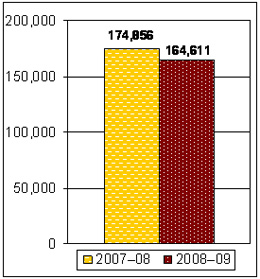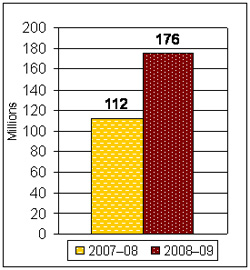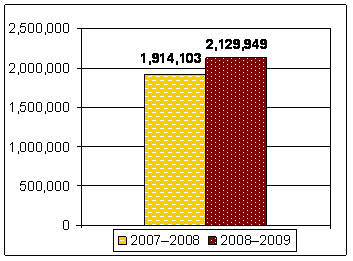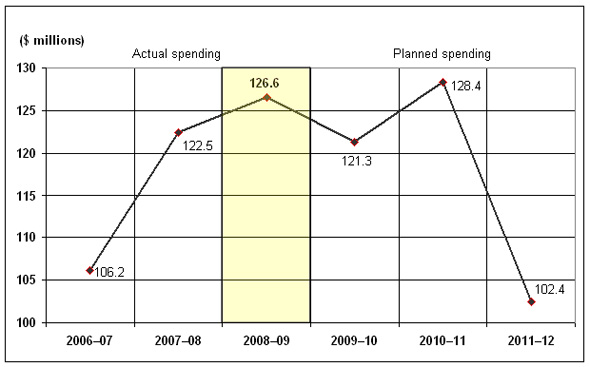Common menu bar links
Breadcrumb Trail
ARCHIVED - Library and Archives Canada
 This page has been archived.
This page has been archived.
Archived Content
Information identified as archived on the Web is for reference, research or recordkeeping purposes. It has not been altered or updated after the date of archiving. Web pages that are archived on the Web are not subject to the Government of Canada Web Standards. As per the Communications Policy of the Government of Canada, you can request alternate formats on the "Contact Us" page.
Minister's Message

The Government of Canada is committed to building a country in which all citizens have the chance to participate in our cultural and economic life. Our Government recognizes the importance of arts and culture in reaching this goal. The agencies and organizations in the Canadian Heritage Portfolio, such as Library and Archives Canada (LAC), are working toward this goal of providing us with opportunities to celebrate and share our rich historical, cultural, artistic, and social heritage.
During 2008–2009, LAC made substantial progress toward becoming a knowledge institution that responds to the interests of Canadians in the 21st century. In a time when Canadians turn to the Internet more and more to find information, the LAC website has become a prime destination for those interested in topics such as genealogy and Canada's democracy. In addition, LAC continued to support our Government's commitment to accountability by ensuring that significant documents produced by the federal government are preserved and made accessible.
As co-host of the World Library and Information Congress that took place in Quebec City in 2008, LAC had the opportunity to share expertise and ideas with thousands of delegates from around the globe on issues related to the management of digital documents. Thanks to partnerships with American and Irish institutions, LAC has made it possible for Canadians to discover sources of documentary heritage of interest to them, but preserved outside of Canada. In collaboration with the United States National Archives and Records Administration, LAC presented the exhibition 1783: Subject or Citizen? The Treaty of Paris, giving the public an opportunity to see the documents that forged present-day North America. The National Archives of Ireland and LAC have established links between Canadian and Irish communities in facilitating access to the Irish census data, which allows many Canadians to trace their personal history to their roots.
As Minister of Canadian Heritage and Official Languages, I am pleased to present the 2008–2009 Departmental Performance Report of Library and Archives Canada. This report provides a detailed account of LAC's accomplishments and demonstrates the ways in which it supports the priorities of our Government. I would like to highlight the efforts that LAC staff have made throughout the year to strengthen the bonds that unite us as Canadians and to contribute to our collective feeling of pride.
The Honourable James Moore, P.C., M.P.
Minister of Canadian Heritage and Official Languages
Section I: Departmental Overview
Raison d'être
The preamble of the Library and Archives of Canada Act states that the mandate of Library and Archives Canada (LAC) is:
- to preserve the documentary heritage of Canada for the benefit of present and future generations;
- to serve as a source of enduring knowledge accessible to all, contributing to the cultural, social and economic advancement of Canada as a free and democratic society;
- to facilitate in Canada co-operation among the communities involved in the acquisition, preservation and diffusion of knowledge; and
- to serve as the continuing memory of the Government of Canada and its institutions.
Responsibilities
The Library and Archives of Canada Act establishes an ambitious, wide-ranging mandate related to acquiring, preserving and making known Canada's collective memory. Through a continuing multi-year process, we have been consolidating and focusing our efforts on the core activities most relevant to our mandate and to the interests of Canadians. Consistent with government-wide priorities, we are reviewing our processes and rethinking our practices to get the best results from our resources.
There are three main sources for the material in our collections, regardless of format. First, Government of Canada departments and agencies transfer to LAC their documents and records of anticipated business or historic value. Second, the legislated requirements of Legal Deposit obligate publishers to provide LAC with copies of material published in Canada. Third, LAC receives various donations, purchases other items and collects more material from the Internet.
To make it easier for Canadians to discover the collections, LAC describes holdings in accordance with national and international standards, which we help to develop and maintain. We are constantly exploring ways to make information resources more accessible. Regardless of format, LAC manages the care of our collections to preserve our collective memory for future generations.
Our responsibilities for the management of Government of Canada digital, paper and other records support government accountability and decision making. They enable Canadians to explore government actions of the past, while our eight Regional Service Centres (formerly Federal Records Centres) manage records in all media on behalf of more than 90 federal government organizations across the country. More broadly, we lead the examination of government recordkeeping issues and identify possible improvements to help meet government priorities and to make federal records more accessible.
Library and Archives Canada: Building Canada's Collective Memory and Making It Accessible to Canadians
- 22 million books, periodicals, newspapers, microfilms, literary texts and government publications
- 167,000 metres of government and private textual records
- 3 million architectural drawings, maps and plans
- 25 million photographs
- 351,000 hours of film, video and sound recordings
- Canada's portrait collection, which includes 21,000 works of art and thousands of caricatures
- 555,000 musical items
- 365,500 items from the documentary art collection, including watercolours, sketches, miniatures and oil paintings
- 1 million items from the philatelic collection
- More than a billion megabytes of digital content
Source: Library and Archives Canada
We make our collections known in many ways. The Library and Archives Canada website has become a major destination for Canadians and people interested in Canada. Our staff members organize exhibitions and learning events that take place in LAC facilities and at partner sites across Canada. We help users understand how our collections and resources are organized and assist them in their searches (see Figures 1 to 3 on the next page related to LAC services). As necessary, we safeguard the rights attached to holdings, such as copyrights and privacy protection. LAC Access to Information responsibilities often involve reviews of archival records from all Government of Canada departments and agencies, personnel records of former civilian and military government employees, as well as LAC operational records.
LAC works in partnership with libraries and archival institutions across the country. We share items and help other Canadian libraries and archives to share resources. This is complemented by our coordination of federal departmental library services. Our National Archival Development Program supports archives across Canada as they contribute to Canada's collective memory.
A Steady Shift to More Online LAC Services to Canadians
Figure 1: Requests from Canadians that LAC answered through traditional services (reference, ATIP, consultation)
Figure 2: Number of page views on the LAC website (in millions)
Strategic Outcome and Program Activity Architecture
This chart shows our program activity architecture (PAA). It illustrates our major activities and the key elements of each that enable us to work towards our main objective. LAC holdings and responsibilities (managing the disposition of the Government of Canada records, managing the documentary heritage of interest to Canada and making the documentary heritage known and accessible to Canadians) enhance knowledge of and foster public engagement in Canada's history and cultural heritage. This links its PAA mainly to a Government of Canada priority called "Social Affairs" and more specifically to the component "A vibrant Canadian culture and heritage."
Figure 4: LAC Program Activity Architecture
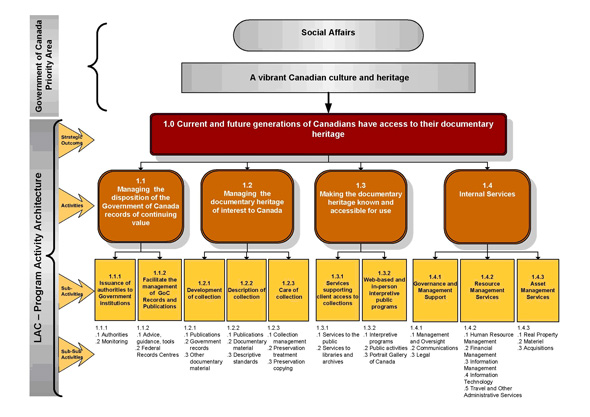
Note: Federal Records Centers are now called Regional Service Centers
Source: Library and Archives Canada
LAC is also related to other Government of Canada priorities; effective recordkeeping is an essential administrative and business foundation within government to achieve results for Canadians and also implicitly supports the Government of Canada priority "Government Affairs." Our responsibilities for the management of Government of Canada records support government accountability, decision making and a fair and accessible Canadian legal and judicial system.
Summary of Performance
| Planned Spending | Total Authorities | Actual Spending |
|---|---|---|
| $175,671.0 | $172,657.8 | $126,592.5 |
| Planned | Actual | Difference |
|---|---|---|
| 1,143 | 1,152 | 9 |
Performance Summary Table
| Performance Indicators | Targets | 2008-09 Performance |
|---|---|---|
| Narrative (preservation, growth of the collection, accessibility) | Not at this level for 2008–09 | Synopsis of progress is presented in the discussion on the contribution of priorities to the strategic outcome |
| Program Activity | 2007-08 Actual Spending |
2008-09 | Alignment to Government of Canada Outcomes | |||
|---|---|---|---|---|---|---|
| Main Estimates |
Planned Spending |
Total Authorities |
Actual Spending |
|||
| 1.1 Managing the disposition of the Government of Canada records of continuing value | $13,588.0 | $12,002.0 | $11,954.0 | $13,654.2 | $13,938.8 | Government Affairs
Social Affairs A vibrant Canadian culture and heritage |
| 1.2 Managing the documentary heritage of interest to Canada | $68,910.9 | $77,166.0 | $95,554.0 | $83,773.2 | $68,776.8 | |
| 1.3 Making the documentary heritage known and accessible for use | $39,957.1 | $68,434.0 | $68,163.0 | $75,230.4 | $43,876.9 | |
| Total | $122,456.0 | $157,602.0 | $175,671.0 | $172,657.8 | $126,592.5 | |
Note: Effective recordkeeping is an essential government administrative and business foundation for service to Canadians. It supports ministerial and managerial accountability within Canada's democratic process. Therefore, Program Activity 1.1 also implicitly supports the Government of Canada priority area "Government Affairs."
Decisions related to three major building projects account for $42.4 million of the $46.1 million variance between Total Authorities and Actual Spending. Two projects under Program Activity 1.2 (a new collection storage facility and a new preservation facility to safeguard Canada's cellulose nitrate-based documentary heritage such as film, photos and negatives) have been approved, but $5.8 million of funding was shifted to 2009–2010 and $6.8 million to 2010–2011 when construction will actually occur. Under Program Activity 1.3, $29.8 million of funding for the construction of a building to house the public programming and exhibitions of the Portrait Gallery of Canada was frozen in November 2008 when the government decided not to pursue the project further.
For more details, please refer to the Financial Performance Summary for 2008-2009 on LAC web site.
Contribution of Priorities to the Strategic Outcome
The priorities set out in the Report on Plans and Priorities for 2008–2009 were the five Strategic Choices that had defined organization-wide management and resource use decisions since 2006. We are now assessing our Strategic Choices through a formative evaluation. This exercise will provide a sound assessment of LAC performance on the success against the high-level outcomes associated with the Strategic Choices. The results of the evaluation will be available and presented in the 2009–2010 DPR. For the 2008–2009 report, we have listed the results from the program activities mapped against each of the Strategic Choices to support the progress made toward reaching LAC's strategic outcomes.
| Strategic Choices | Type | Status / Linkages to Program Activities |
|---|---|---|
| 1. LAC will adjust all aspects of its activities to adapt to the needs and benefit from the opportunities of the digital information environment | Previously committed | Program Activity 1.1
Program Activity 1.2
Program Activity 1.3
Program Activity 1.4
|
| 2. LAC will increase the relevance and accessibility of LAC collections and expertise to Canadians outside the National Capital Region | Previously committed | Note: Actions under Strategic Choice 1 that expand and enhance LAC's collections, tools and resources online also contribute to progress on this Strategic Choice Program Activity 1.2
Program Activity 1.3
|
| 3. LAC will focus its role in Government of Canada information management on the development of effective recordkeeping | Previously committed | Program Activity 1.1
|
| 4. LAC will make systematic use of collaborative arrangements and will increasingly deliver on its mandate through or with others | Previously committed | Program Activity 1.1
Program Activity 1.2
Program Activity 1.3
|
| 5. LAC will ensure that citizen/client research and evaluation results are built into management decision making | Previously committed | Program Activity 1.3
Program Activity 1.4
|
Building on Experience to Drive Change Further in LAC
In 2008, Library and Archives Canada began work on operationalizing the key components necessary for the institution to meet its strategic objectives as articulated in our Act and in the Strategic Choices. We began by exploring initiatives which have provided the foundation for the modernization of the institution and the three key areas of LAC responsibility.
Acquisition and Documentation: We began the initial work of considering how best to guide, coordinate and articulate choices about what LAC should focus on acquiring for the collection, given our unique mandate and accountabilities in the digital environment context. This includes assessing how we can collaborate with other knowledge institutions on acquisition efforts. It also includes determining how to take into account the ongoing resource implications for LAC of any acquisition over time, such as preservation and collection management costs.
Preservation: We began the initial work of reconsidering our preservation activities and priorities, including the ongoing management of digital content. Given the scope and scale of our current collection and our commitment to make it more accessible to users, we have begun to assess how to balance our acquisition and preservation options, given criteria such as documentary value and the ongoing costs of preservation and accessibility.
Resource Discovery: We have begun the initial work towards improving how users find items in LAC's collection easily and intuitively, as well as enabling them to discover additional resources of interest. We also have begun to think about how to open new avenues for collaboration, so that users and partners can provide information about items and their context that will be relevant to other users.
We also identified two critical internal issues for attention that have to be addressed to generate the best possible results. First, we have begun to consider how we can work with our professional staff to help them manage the expected fundamental shifts in their work ahead. Second, we have begun to consider how to approach modernizing functions in areas such as human resources, policy development and information technology that are essential enablers for us to achieve results.
While all of this work was at early stages by the end of 2008-2009, it points to important change ahead for LAC. We intend to take into consideration the new thinking generated by this modernization exercise in assessing all our 2008-2009 results and ongoing strategies.
Risk Analysis
Library and Archives Canada operates in a rapidly changing environment. LAC planning and priority-setting draws on comprehensive risk analysis. In the 2008–2009 Report on Plans and Priorities, we identified five risks of ongoing relevance throughout LAC program activities. They took into account issues such as preservation of digital and analogue documentary heritage in a digital environment, financial pressures and risks related to the technologies we use or we plan to introduce, the infrastructure we operate and the skilled human resources on which we rely to deliver results for Canadians.
Our risks reflect realities such as the expectations of Canadians that they should be able to gain access to the LAC collection online, no matter what its original format was, even as demand continues in our traditional service channels. More information, including government information, is now born digital, such as websites or emails, while the array of non-digital items we collect or could add also continues to grow, which creates challenges for all of our collection development, documentation and preservation activities. We have been working with colleagues across Canada, across government and across the globe to find effective approaches to these challenges and to mitigate our risks. As we have renewed our workforce, we have been seeking employees and managers who can work and manage in this evolving, complex environment, thereby combining new and traditional competencies with the ability to bring continued innovation to the institution to address the leadership and capacity challenges of the 21st century.
LAC managers have addressed our priorities and addressed risks to best respond to the challenges of a digital information world in normal program operations. For example, we have addressed financial sustainability risks and risks associated with our infrastructure by taking a harder look at our storage of government records. In particular, we have taken steps to focus our storage resources solely on records of archival value. This is both reducing LAC costs and our need to acquire and manage storage space. Similarly our audit and evaluation processes are enabling us to identify and mitigate specific risks.
The Library community came to the city of Québec
In August 2008, Library and Archives Canada co-hosted with Bibliothèque et Archives nationales du Québec the 74th General Conference and Council of the International Federation of Library Associations and Institutions (IFLA), which was held in Québec. Approximately 3,000 delegates from 100 countries took part in the World Library and Information Congress, the leading worldwide event in its field.
At the conference, an international group of representatives from national libraries was formed to discuss issues related to file format registries and their role in digital preservation. The objective of the Unified Digital Registry Working Group is to develop an automated tool to make file format data globally accessible enabling efficient metadata recording. Since we operate in an environment of large scale digital collections using diverse format profiles, this tool will advance the digital preservation agenda.
Expenditure Profile
The chart below depicts LAC's spending trend over a six-year period (three years of actual spending and three years of planned spending).
Figure 5: Spending Trend
The higher level of spending over four years beginning in 2007–2008 is due to temporary funding for specific projects as described below. Upon conclusion of these projects, spending will decrease by $26 million reflecting approximately LAC's permanent funding level.
- Over three years beginning in 2007–2008, $21.7 million will have been invested in replacing obsolete systems and providing the capacity for managing electronic publications and digital records of the Government of Canada;
- In 2008–2009, LAC received approval for the construction of a preservation facility that will safeguard Canada's cellulose nitrate-based documentary heritage (photographs and films). We anticipate spending $12.5 million in 2009–2010 and an additional $1.5 million the following year; and
- Planned spending also includes $24.1 million through 2010–2011 to increase LAC's collection storage capacity.1
These projects advance LAC's mandate to safeguard Canada's documentary heritage. LAC continues to ensure the availability of preservation capacity to meet the needs of Canada's collection.
1 Note that these funding levels are subject to change. Further details will be provided in the next RPP and DPR.
For details on financial variances, please refer to the Financial Performance Summary for 2008-2009 on LAC web site.

